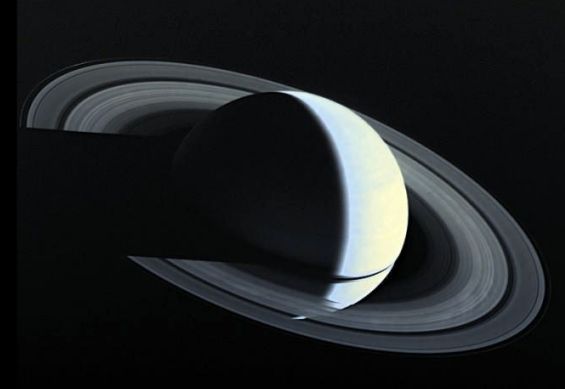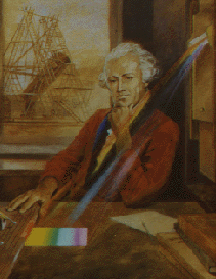Astronomy: Post-Newtonian Astronomy
In the 1700's and 1800's, science (or 'natural philosophy') continued
to develop and grow. Growth in astronomy was assured by the continued
application of the telescope, and better telescopes were always being
manufactured. In telescope-making, "bigger" is usually
"better". Observatories were built. Observatoire de Paris 1671, Royal
Observatory in Greenwich 1676, Royal Observatory of Berlin
1700. Private observatories were built by William Herschel (1780) and
the Earl of Rosse (1825). The Imperial Observatory of Russia was built
in 1839, and in the United States, Lick Observatory (1888) and Yerkes
Observatory (1897), both funded by private donors.
- Giovanni Cassini (Obs. Paris) discovered 4 satellites of Saturn
and measured the rotation periods of Mars (24h, 40m) and Jupiter
(9h, 56m). He correctly deduced that the rings of Saturn were
composed of numerous "moonlets". Cassini triangulated the
distance of Mars by sending a collaborator (Jean Richer) to
French Guiana and using the distance between them as a
baseline. Both observers simultaneously measured the exact
position of Mars against the background of distant stars and
this gave them the distance of Mars, in miles, not
astronomical units. The solar system turned out to be
staggeringly large. The sun was not 20 times further away than
the moon (Aristarchus) nor 60 times further away than the moon
(Kepler) but a staggering 400 times further away.

- Olaus Romer, a Dane working at Paris with Cassini's data on
Jupiter's moons, noticed that the moons did not keep time very
well. He correctly deduced that a finite speed of light could
produce the observed effect, and measured the speed of light to
be 214,000 km/s (not far from the true value of 300,000
km/s). Future attempts to measure the speed of light were
ground-based, but Romer set the ballpark figure that
experimentalists tried to reproduce.
- John Flamsteed (1646-1719; Greenwich) made a catalog of 3000 stars that far
surpassed Tycho Brahe's work: the position accuracy was 60 times
better: one second of arc rather than Tycho's one minute of
arc. The increased accuracy was due entirely to the telescope.
- Organist and composer William Herschel (1738-1822), with his private observatory, discovered the
planet Uranus in 1781. Needless to say, the discovery of a new
planet really impressed everybody, and Herschel was to continue
to observe the rest of his life. He was aided by his sister,
Caroline Herschel. Caroline carried out many observations
herself, but neither wanted nor received much credit. The Herschels
also discovered 2 moons around Uranus and the 6th and 7th moons of Saturn.

- In 1845, in a triumph of Newtonian mechanics, two mathematicians,
working independently, discovered the planet Neptune by its mild
effect on the orbit of Uranus, which had been observed
intensively for the 50
years since its discovery and whose orbit was a "perturbed
ellipse". The mathemeticians, Adams and Leverrier, postulated
that an unknown planet was tugging on Uranus and both of them
correctly deduced the position of the unknown planet. It is
Adams and Leverrier who are given credit for the discovery, not
Johann Galle, the man who first saw Neptune when he pointed his
telescope to the position indicated by Leverrier.
- This does not fit chronologically, but Pluto was discovered by
Clyde Tombaugh in 1930, during a well-planned systematic
photographic search for planets at Lowell observatory near
Flagstaff, Arizona.
- James Bradley, of London, discovered that the earth was truly
moving through space by discovering "stellar abberation," a
slight change in position due to the fact that the earth is
moving (at 30 km/s) around it's orbit, so that a star will shift
to a slightly (20 arcseconds) different position 6 months later,
when the earth is heading 30 km/s in the opposite direction.
- The catholic church permitted the publication of "Complete Works
of Galileo" in 1741.
- The year for the detection of stellar parallax was 1838: finally,
stars were observed to wobble as the earth sloshes back and
forth in its orbit. A Russian, a German, and an Englishman each
separately detected parallax in three different stars. The
closest of the stars was 1.25 parsecs (4 light-years) away, and
the furthest was 10 parsecs. As when Cassini measured the true
size of the solar system, the sheer awesome size scale revealed
by this discovery left many stunned.
- "Faint fuzzies 1:" Charles Messier of France had a great interest
in comets, seen as fuzzy patches of light that moved through the
stars from day to day. But there were other fuzzy patches in the
sky that did NOT move. These fuzzy spots were called nebulae
(singular: nebula),
and Messier made a catalog of 109 of them in 1784. We still use
Messier's catalog today.
- "Faint fuzzies 2:" William and Caroline Herschel went much
further and cataloged 7840 nebulae! These were collected in the
"New General Catalog of Nebulae" a catalog that, with updates,
is still used today. We will talk more about the various kinds
of nebulae (spiral nebulae, diffuse nebulae, planetary nebulae)
later.
- Heinrich Wilhelm Olbers: In 1826, with each advance in
telescope-making revealing more and more stars, it was thought
that the universe was composed of stars to its limits. Olbers
pointed out that the universe must be finite either in space or
in time, or else the whole sky should be ablaze with starlight.
In the middle 1800s both the spectrograph (prism, by which different
colors [wavelengths] are spread out) and the photographic plate caused
great advances in astronomy. William Huggin (1864) took the first
photograph of the spectrum of a star (besides the sun, which is bright
enough to have been studied by eye). These spectra are bright washes
of light except for dark notches at specific wavelengths. This is an
absorption line spectrum, which looks just like a continuous
spectrum except that no dark lines are seen in a continuous
spectrum. Parallel laboratory work, in which spectra were obtained
from the glow from superheated materials, showed emission line
spectra whose bright lines corresponded in wavelength exactly with
the dark lines seen in stars. For instance, the twin lines of sodium
at 595nm wavelength are seen in laboratory flames, the sun, and many
stars. We had discovered that the universe of stars shared a common
chemistry with the earth.
There are a host of developments in physics in the 1800s that we will
mostly skip. Here are the highlights, selected for direct relevance to
astronomy.
- Nature of light: Newton had thought that light was composed of
particles, little bullets that traveled at the speed of light. But
Thomas Young was to show that light has extremely strong wavelike
properties by shining light through two narrowly spaced slits. The
image cast on the screen was not that of two slits, but a whole series
of light and dark stripes (fringes). The only way this pattern could
emerge is if light is a wave, and the different waves add (or
subtract) from each other when they overlap. This is called
interference. Light's wavelength could be measured (350-700 nm) for
visual light, but light can be found with any wavelength you
like - we just can't see most of it with our eyes.
- C. J. Doppler showed in 1842 that relative motion shifted the
wavelength of light. If moving toward us, an object's emitted light is
compressed to shorter wavelengths - the blueshift. Away - redshift.
- Count Alessandro Volta made the first battery in 1800.
- From 1820-1830, Michael Faraday showed that all of magnetism
comes from moving electric charges, so that magentism and electricity
are really one force: electromagnetism. Faraday also invented the
electric motor, generator, and transformer!
- James Clerk Maxwell published the mathematically elegant,
complete theory of electromagnetism in 1871. Maxwell showed that his
equations had a wave-solution that traveled exactly at the speed of
light. This was a stunner, and put Maxwell's name just below Newton on
the famous scientist roster. (There is no such thing - I made that up
- but you get the idea.)
- With Maxwell's predictions in hand, Heinrich Hertz discovered radio waves
of about 5 meters wavelength, and Wilhelm Konrad von Roentgen discovered
X-rays (a few tens of nm wavelength). These new kinds of light would
not be fully utilized by astronomers until after world war 2.
Last modified: Wed Oct 4 22:24:42 CDT 2000



